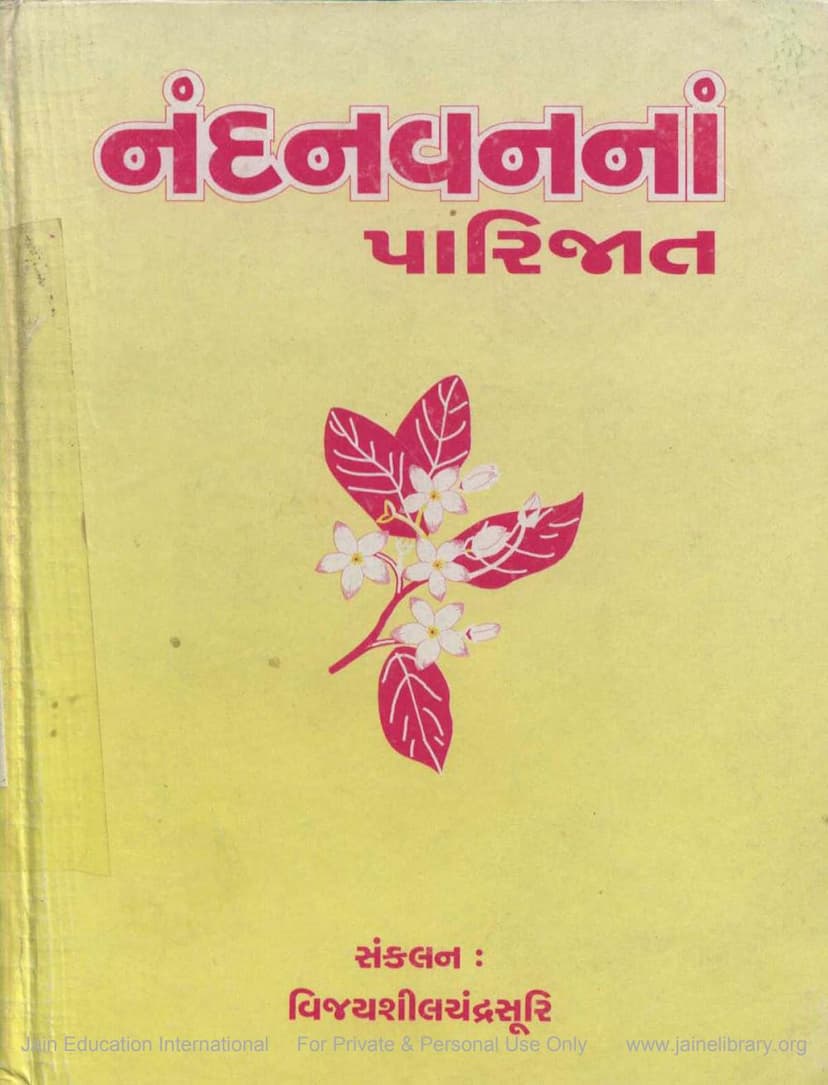Nandanvanna Parijat
Added to library: September 2, 2025

Summary
Here's a comprehensive summary of the Jain text "Nandanvanna Parijat," based on the provided pages:
Book Title: Nandanvanna Parijat (The Parijat of the Nandanvan Garden) Author(s): Nandansuri, Shilchandrasuri Compiler: Vijayshilchandra Suri Publisher: Shri Vijayanandan Suri Smarak Trust, Ahmedabad
Overall Theme: "Nandanvanna Parijat" is a compilation of profound spiritual teachings and insights, primarily attributed to the teachings and sayings of Acharya Nandansuri, and possibly expanded upon by Shilchandrasuri. The book offers guidance on living a righteous Jain life, understanding spiritual principles, overcoming worldly attachments, and ultimately achieving liberation (moksha). It emphasizes the importance of right faith (samyak darshan), right knowledge (samyak gnan), and right conduct (samyak charitra).
Key Themes and Teachings:
-
The Nature of Karma and Suffering:
- The text repeatedly highlights the unpredictable nature of karma ("karm no vipak") and its consequences, urging constant vigilance and avoiding even a moment of negligence (pramad).
- It explains that suffering (tapa or dukha) comes in three forms: adhyatmik (internal, arising from anger, pride, deceit, greed), adhibhautik (physical, due to the elements and bodily ailments), and adhidaivik (from external beings like animals or deities).
- The futility of worldly pleasures and possessions is stressed, as they are transient and ultimately lead to more suffering.
-
The Essence of Jain Philosophy:
- The "Tripadi" (three-fold truth) is presented: the origin of things, their impermanence (destruction), and their inherent stability. This highlights the nature of reality as being relative and dependent on perspective.
- Tradition (Parampara) as Authority: The text asserts that tradition is a valid form of proof, even more potent than law, and is a testament to the timeless nature of Jain teachings.
- The Authority of Aagams: The words of the enlightened ones (Arahants and their disciples) are presented as the only true and complete explanation of the world's various states and principles, contrasting them with incomplete or erroneous views from other philosophies.
-
Living a Virtuous Life:
- Equanimity: The importance of maintaining a balanced state of mind in both prosperity and adversity is emphasized, drawing an analogy from the sun's consistent color during sunrise and sunset.
- The Three Causes of Untruth: Lying stems from attachment (raag), aversion (dwesh), or ignorance (ajnan). Those free from these are unlikely to speak untruth.
- Devotion and Faith: Even if one cannot perform great austerities, rituals, or charity, unwavering faith and love for the Lord's teachings and His Shasan (dispensation) are paramount. This devotion is the true essence.
- The Goal of Life: The ultimate goal is liberation (moksha), characterized by the absence of birth, old age, death, physical and mental suffering. Different interpretations of moksha are acknowledged, but the underlying aim remains the same.
-
The Path to Liberation:
- Self-Inquiry (Jijnasa): The text stresses the importance of curiosity and the desire to know the truth about oneself and the world. True inquiry leads to spiritual growth.
- The Importance of a Guru: The necessity of a Guru for spiritual guidance is highlighted. A true guru imparts wisdom, and a sincere disciple is one who listens with humility and eagerness.
- Righteous Conduct (Achar): Mere knowledge is insufficient. It must be accompanied by right action (karma yoga). The example of medicine knowledge without taking the medicine illustrates this point.
- Virtue and Vice: The text contrasts the path of virtue (punya) with that of vice (paap), emphasizing that acts of helping others lead to merit, while causing pain leads to sin.
- The Four Bhavanas (Meditations):
- Maitri (Friendliness): Wishing no harm and desiring well-being for all living beings.
- Pramod (Appreciative Joy): Rejoicing in the virtues and good deeds of others.
- Karuna (Compassion): Feeling pity for those in suffering and making efforts to alleviate it.
- Madhyasthya (Equanimity/Neutrality): Maintaining a balanced view towards those with virtues and those with vices, showing compassion even to the wrongdoers.
-
The Nature of Happiness and Attachment:
- Detachment from Worldly Possessions: The transient nature of relationships (wife, children) and wealth is repeatedly stressed. They are not carried along after death, and clinging to them causes suffering.
- Contentment (Santosh): True happiness lies in contentment, not in the accumulation of worldly pleasures, which only increase desire.
- The Illusion of Material Happiness: Happiness derived from material possessions, sensory pleasures, family, and even food is fleeting and mixed with suffering.
-
The Importance of Self-Awareness and Introspection:
- Self-Realization: The text encourages introspection about one's true nature, origin, and destination. It distinguishes between vibhav dasha (state of flux/attachment) and swabhav dasha (true nature/state of purity).
- The Meaning of Life and Death: True life is found in accepting one's circumstances with joy and equanimity, while constant worry, desire, and negative emotions constitute a form of spiritual death.
-
The Efficacy of Austerities (Tapa):
- Fasting and other forms of austerity are presented as powerful tools for weakening the senses, reducing desires, and incinerating karmic bondage. They are described as "nectar for moksha."
-
The Role of the Guru and Guidance:
- The importance of following the guru's instructions without doubt or questioning is emphasized, even if the instructions seem unusual.
- The text differentiates between true spiritual seekers and those who merely talk about spirituality without practicing it.
-
The Kali Yuga and Spiritual Practice:
- The current era (Kali Yuga) is acknowledged as challenging but also potentially beneficial, as it allows for the shedding of more karma in a shorter time with sincere practice.
Overall Message: "Nandanvanna Parijat" is a guide for the spiritual aspirant, offering practical wisdom and profound philosophical insights. It encourages detachment from worldly attachments, unwavering faith in the teachings of the Tirthankaras, diligent practice of virtues, and continuous self-reflection to attain ultimate liberation. The book serves as a reminder that true happiness and lasting peace are found within the soul, through the practice of Jain principles.